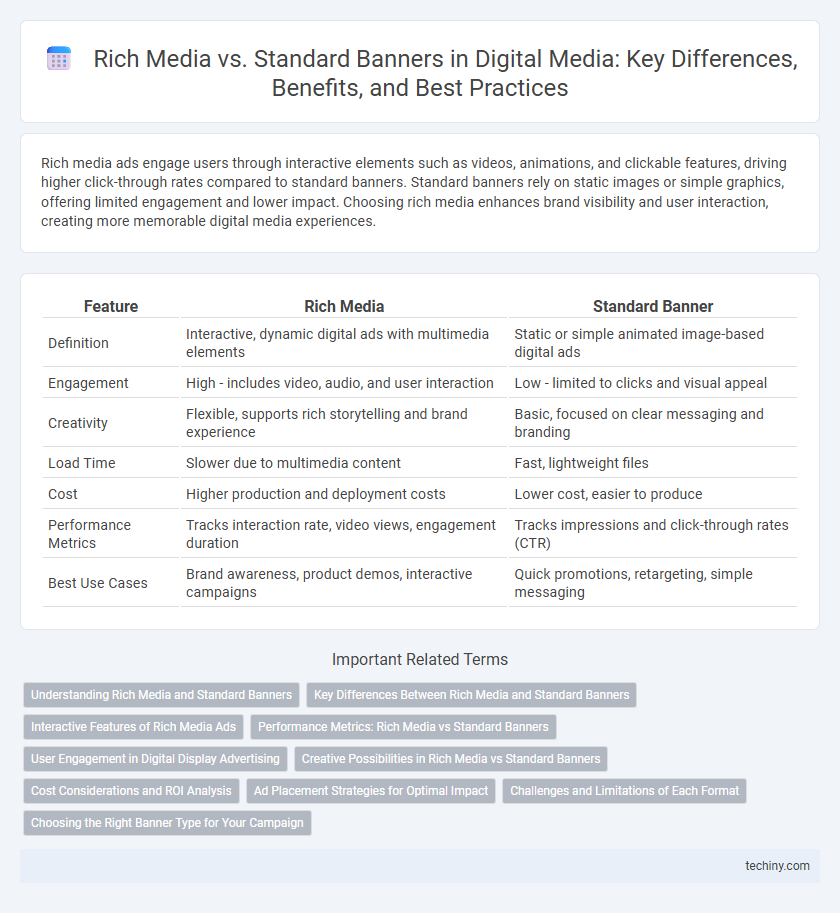Rich media ads engage users through interactive elements such as videos, animations, and clickable features, driving higher click-through rates compared to standard banners. Standard banners rely on static images or simple graphics, offering limited engagement and lower impact. Choosing rich media enhances brand visibility and user interaction, creating more memorable digital media experiences.
Table of Comparison
| Feature | Rich Media | Standard Banner |
|---|---|---|
| Definition | Interactive, dynamic digital ads with multimedia elements | Static or simple animated image-based digital ads |
| Engagement | High - includes video, audio, and user interaction | Low - limited to clicks and visual appeal |
| Creativity | Flexible, supports rich storytelling and brand experience | Basic, focused on clear messaging and branding |
| Load Time | Slower due to multimedia content | Fast, lightweight files |
| Cost | Higher production and deployment costs | Lower cost, easier to produce |
| Performance Metrics | Tracks interaction rate, video views, engagement duration | Tracks impressions and click-through rates (CTR) |
| Best Use Cases | Brand awareness, product demos, interactive campaigns | Quick promotions, retargeting, simple messaging |
Understanding Rich Media and Standard Banners
Rich media ads incorporate interactive elements such as video, audio, and animations to engage users more effectively than standard banners, which typically consist of static images or simple GIFs. The enhanced interactivity and dynamic content in rich media increase click-through rates and user engagement by delivering a more immersive advertising experience. Standard banners, while easier to produce and less resource-intensive, often result in lower engagement levels due to their limited visual appeal and lack of interactive features.
Key Differences Between Rich Media and Standard Banners
Rich media ads incorporate interactive elements such as video, audio, and animations, enhancing user engagement beyond the static nature of standard banners. Standard banners typically consist of static images or simple graphics, making them less dynamic and less effective in capturing audience attention. The advanced capabilities of rich media enable precise tracking of user interactions, providing marketers with detailed performance metrics compared to the limited tracking options of standard banners.
Interactive Features of Rich Media Ads
Rich media ads significantly enhance user engagement by incorporating interactive features such as video, audio, and expandable elements, which standard banners lack. These interactive components facilitate deeper brand storytelling and allow for real-time user interaction, improving click-through rates and conversion metrics. Leveraging advanced technologies like HTML5, rich media ads adapt seamlessly across devices, offering dynamic content experiences that standard banners cannot match.
Performance Metrics: Rich Media vs Standard Banners
Rich media ads deliver higher engagement rates with an average click-through rate (CTR) of 0.5% compared to 0.1% for standard banners, driven by interactive elements such as video, audio, and animations. Viewability metrics also favor rich media, showing a 70% viewability rate, outperforming the 50% average for standard banners, which boosts brand recall and user interaction. However, standard banners maintain faster load times and lower bounce rates, making them suitable for campaigns prioritizing reach and speed over deep engagement.
User Engagement in Digital Display Advertising
Rich media ads significantly enhance user engagement in digital display advertising by incorporating interactive elements such as video, audio, and clickable features that standard banners lack. Studies show rich media increases click-through rates by up to 20% compared to static banners, capturing user attention more effectively. This higher engagement translates into improved brand recall and conversion rates, making rich media a preferred choice for advertisers targeting active user interaction.
Creative Possibilities in Rich Media vs Standard Banners
Rich media offers interactive elements such as video, audio, and animations that significantly enhance user engagement compared to standard banners, which primarily rely on static images and basic text. Advanced targeting and real-time data integration in rich media campaigns allow for personalized and dynamic content delivery, driving higher click-through rates and conversions. Creative possibilities in rich media enable immersive storytelling and brand experiences that standard banners cannot achieve with their limited design scope.
Cost Considerations and ROI Analysis
Rich media ads typically incur higher production and placement costs compared to standard banners due to interactive elements and advanced features. However, their engagement rates and click-through performance often lead to a superior ROI by driving more user interactions and conversions. Marketers should evaluate the cost per acquisition and long-term value generated to determine the optimal investment between rich media and standard banner campaigns.
Ad Placement Strategies for Optimal Impact
Rich media ads leverage interactive elements and dynamic content to captivate audiences more effectively than standard banner ads, which rely on static images or simple animation. Strategic ad placement in high-traffic areas such as premium websites or relevant content sections significantly enhances user engagement and conversion rates for rich media campaigns. Employing programmatic buying and geo-targeting further optimizes the delivery of both rich media and standard banners, ensuring the ads reach the most receptive audience segments for maximum impact.
Challenges and Limitations of Each Format
Rich media ads offer enhanced engagement through interactive elements but face challenges including higher production costs, longer load times, and potential compatibility issues across devices and browsers. Standard banners provide simplicity and faster loading speeds, yet their static nature limits user interaction and effectiveness in capturing attention in a crowded digital environment. Both formats encounter constraints related to ad blindness and limited space for conveying complex messages, impacting their overall performance and ROI in digital marketing campaigns.
Choosing the Right Banner Type for Your Campaign
Selecting the right banner type for your digital media campaign hinges on your marketing goals and audience engagement levels. Rich media banners incorporate interactive elements like video, audio, and animations, driving higher click-through rates and brand recall compared to standard banners, which rely solely on static images. Evaluating budget constraints and campaign objectives helps determine whether the dynamic appeal of rich media or the simplicity of standard banners delivers optimal ROI.
Rich Media vs Standard Banner Infographic

 techiny.com
techiny.com